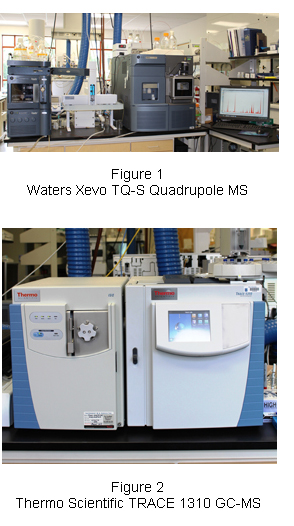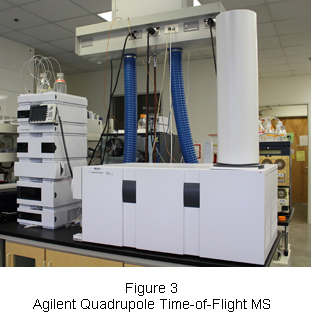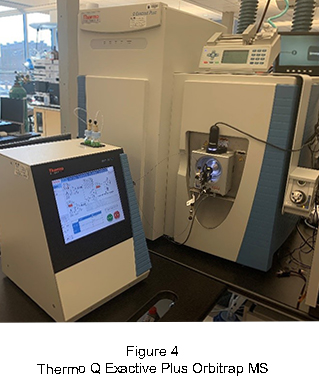Targeted Metabolomics

The DMPI Metabolomics Laboratory has a comprehensive suite of thirteen MS instruments (Waters, Agilent, Sciex, and Thermo Fisher) that allow both targeted and non-targeted metabolomics assays to be conducted on a wide array of sample types including plasma, blood spots, tissue, urine, cerebral spinal fluid, and cell culture. For targeted analyses, the lab deploys four triple quadrupole (MS/MS) instruments (Figure 1) and a gas chromatography (GC)/MS instrument (Figure 2) to measure more than 300 specific metabolites across seven chemical classes: 1) 66 species of acylcarnitines; 2) 47 amino acids and biogenic amines 3) 67 acyl CoAs species; 4) 20 organic acids; 5) 21 ceramides; 6) 34 sphingomyelins, and 7) 36 nucleotides and purine/pyrimidine pathway intermediates. Accurate quantitation of the metabolites in the targeted assays is achieved by using isotope dilution or pseudo-isotope dilution techniques and quality control calibrators derived from biologic matrices and commercially available analytical standards.
Non-targeted metabolomics

To complement the strong targeted platform, non-targeted metabolomic methods have been developed to greatly expand coverage of the metabolome across many biochemical classes of metabolites. The non-targeted GC/MS-based platform involves chemical derivatization with electron-ionization mass spectrometry. In collaboration with Agilent Technologies, Inc., the laboratory has created one of the world’s largest retention-time-indexed spectral libraries of metabolites, which is used to identify metabolites that could reveal novel biochemical pathways and interactions. Another non-targeted approach under active development is based on high-performance liquid chromatography (HPLC)-MS. This method involves reverse-phase and hydrophilic interaction LC coupled to a quadrupole, time-of-flight mass spectrometer (Figure 3) which operates in both positive and negative ionization modes. This high-resolution platform will provide a tremendous expansion in the coverage of the metabolome.
Stable isotope-based metabolic flux analysis
In addition to the targeted and non-targeted analyses, the DMPI Metabolomics Laboratory applies LC-MS/MS and GC/MS methods to trace stable isotope-labeled substrates in isolated cells, perfused organs, and intact animal models, thereby providing a means for integrating static metabolomic profiles with changes in metabolic flux. Examples of the application of these technologies to recent DMPI projects include analysis of branched-chain amino and ketoacid metabolism in vivo and in isolated perfused tissues such as the heart, measurements of hepatic de novo lipogenesis, and analysis of metabolism of multiple metabolic substrates involved in regulation of hormone secretion from the pancreatic islets of Langerhans.
A key feature of the DMPI metabolomics core laboratory is its long experience with internal and external collaborative projects, which provides a level of experience in data interpretation and translation not found in most other labs of its kind. The laboratory employs dedicated PhD-level personnel who are equipped to assist collaborators with interpretation of the various kinds of metabolomics data sets described above, and to help our colleagues to understand the data in a physiologic and pathophysiologic context. In addition, our scientists can draw upon the expertise of senior DMPI faculty when needed, thereby increasing the probability that a collaborative project with DMPI will have a productive outcome. Firmly supporting this statement, the DMPI Metabolomics core laboratory has led or co-authored >300 publications in leading scientific journals. In addition, the DMPI Metabolomics core laboratory is a key component of several NIH-funded consortia including the Molecular Transducers of Physical Activity (MoTrPac) consortium, the Nutrition for Precision Nutrition/All of Us Research program, the North Carolina Diabetes Research Center (NCDRC) funded by a Diabetes and Endocrine Research Center (DERC) award shared by Duke, UNC-Chapel Hill, Wake Forest, and NC A&T, and the NIH-sponsored RADIANT consortium investigating atypical forms of diabetes.
MS-based proteomics: protein quantitation and post-translational modifications

Our proteomics nLC-MS/MS platform consists of a high resolution/high mass accuracy Q Exactive Plus (QE+) Orbitrap mass spectrometer (Thermo) with a front end EASY-nLC 1200 UHPLC system (Figure 4). Many projects employ a “bottom up” discovery approach, where proteins are digested with a proteolytic enzyme (eg., trypsin), producing peptides to monitor by either label-free or isobaric tag (e.g., TMT)-based relative quantitative strategies. Discovery projects that prioritize protein quantitation typically use the label-free approach, whereas labeling with TMT reagents allows for simultaneous measurements of relative protein abundance along with post-translational modifications (PTMs), such as phosphorylation and acetyl/acylation. Although proteomics is the newer “omics” in the DMPI Metabolomics/Proteomic core lab, similar to the metabolomics group, multiple publications in top journals have been contributed by the proteomics team.
DMPI has multiple licensed copies of Proteome Discoverer (Thermo), a leading informatics platform that integrates seamlessly with Orbitrap technology. The software is installed on workstation PCs (~100 GB RAM) networked to our secure fileserver system. Downstream data reduction is performed using in-house R/Python scripts, which provide quantitative normalization, statistical analysis, data visualization, and interrogation of biological networks. We also leverage the QE+ for targeted proteomics, typically using parallel reaction monitoring (PRM) and Skyline software for data acquisition and analysis, respectively. For targeted projects, including those seeking to measure intact peptide hormones (i.e., omitting protein digestion), internal standard peptides are used for absolute quantitation by isotope dilution.
